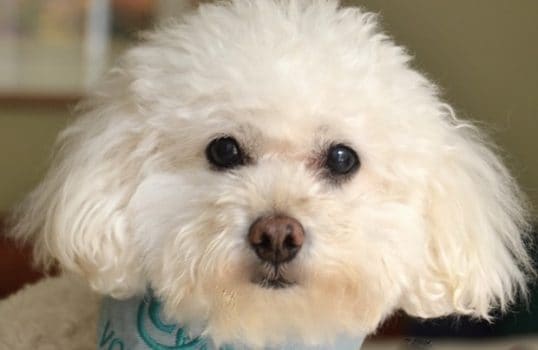Many pet owners know how therapeutic dogs are, and retired executive Mark Friedman is one of them. Friedman’s white Toy Poodle, Max, even has his own fan club.
As part of the Barbara Cowen POOCH (pets offering ongoing care and healing) program at Cedars-Sinai Medical Center in Los Angeles, Max is welcome with open arms every time he and Friedman walk through the hospital’s doors. One doctor in particular will sit down on the floor to hold and hug Max whenever she sees him.
“She calls it ‘Max time,’” he says.
About five years ago, Max’s vet suggested Friedman consider getting Max trained as a therapy dog because of his wonderful, mellow temperament. The vet turned out to be right.
“To see him is to love him,” Friedman says.
Since he began his work with the program, Max has comforted a number of patients. The program director once asked Friedman to bring Max to the hospital for one special request: to see a dying patient off.
“He helped someone leave this world with some level of peace,” Friedman says. “It was very touching.”
On another visit, Max was in the room with a patient who was due to get a shot to ease his pain. He turned it down after telling the nurse that his time spent with Max helped relieve him just as much.
Why is Max so popular? For starters, at just eight-and-half pounds, he’s the perfect size for cuddling.

“He’s able to be in bed with the patient and they are able to hold him,” says Friedman, who adds that Max will snuggle with patients and rest his head on their shoulders and arms.
And Max takes his job seriously. Dogs in the program wear blue bandanas to identify themselves.
“The minute that I put on the bandanna on him, it’s like he knows he’s going into a routine,” Friedman says.
The dogs also have their own “training cards” with a photo and facts about them printed on their side. Max’s reads:
His birthday: Thanksgiving. Max is 17.
Favorite dog toys: one-armed monkey and a green elephant
Favorite treats: venison jerky, carrots, pears
Fun facts: Max loves to watch TV. He loves travel on the car. The longer the ride, the better.
Max is one of about 40 dogs enrolled in the program, each of who spreads their joy to more than just the patients of the hospital.
“So many times, the staff needs it just as much as the patient,” says Camille Camello-Zendejas, a volunteer coordinator with the program, which started in 1992. “It really just gets the nurses and the doctors to stop what they’re doing and take a moment for themselves.”
During a typical shift, the dogs have at least 10 patients on their “visit list,” but aren’t required to see them all (the program emphasizes quality over quantity, Camello-Zendejas says). The list includes patients who have requested a visit in addition to nurses, doctors and social workers who have recommended certain patients receive them. The dogs come in twice a month for about two hours at a time.
Before they can see patients, both the dogs and their owners complete a rigorous screening process. They are interviewed by Camello-Zendejas, assessed by the hospital’s veterinarian then complete a training program and an orientation before being allowed to work their magic.
“It’s amazing what the dogs can do,” says Camello-Zendejas.

Teresa K. Traverse is a Phoenix-based writer, editor, traveler and dog mom to Chihuahuas Autumn and Rocket.
Share:









